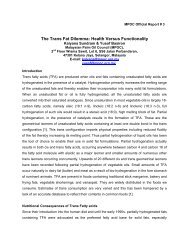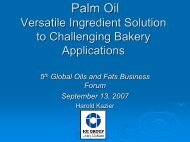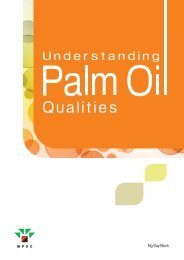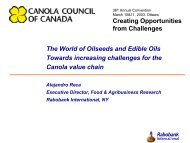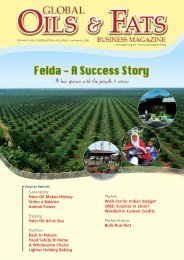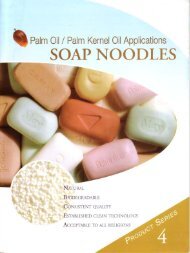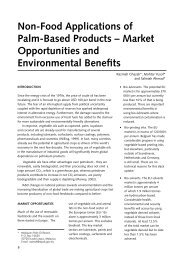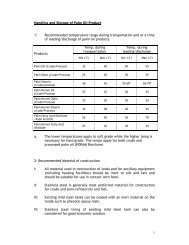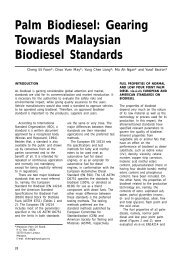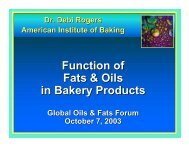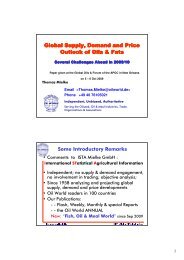Josipa Paska.pdf - American Palm Oil Council
Josipa Paska.pdf - American Palm Oil Council
Josipa Paska.pdf - American Palm Oil Council
Create successful ePaper yourself
Turn your PDF publications into a flip-book with our unique Google optimized e-Paper software.
THE PALM OIL SOLUTION<br />
Utilizing Unique Characteristics of <strong>Palm</strong> <strong>Oil</strong> in Foods<br />
By: <strong>Josipa</strong> <strong>Paska</strong><br />
October 7, 2003.<br />
1
“The Poisoning of America”<br />
Remember this?<br />
• 1990 – “The Wall Street Journal” and other major newspapers<br />
• P. Sokolf alerting the country to the dangers of highly saturated<br />
tropical oils:<br />
• causing an increase in blood cholesterol<br />
• build up of arterial plaque<br />
• and finally…<br />
2<br />
Ref. NHSA
The Nation’s Number One Killer<br />
Heart attack is the leading cause of<br />
death in America<br />
3
"The Poisoning of America”<br />
• calling for elimination of deadly coconut and palm oil<br />
• thanks to Sokolof, thousands of products were re-formulated<br />
• Sokolof credited with passage of Food Labeling Law<br />
“ We would not be here today if not for the<br />
efforts of Mr. Sokolof”<br />
said Congressman Henry Waxman at the bill signing ceremony<br />
4<br />
Ref. NHSA
Post Sokolof Era<br />
During the last 13 years<br />
• most of the palm oil taken out of foods<br />
• increase in use of hydrogenated domestic, or soft oils<br />
• selective hydrogenation allowing build up of trans fatty acids<br />
• to “steepen” the melting curve<br />
• increase product hardness<br />
• to “eat better”<br />
Why?<br />
5
Fact<br />
<strong>American</strong>s receive on average 2.6 -3.0% of daily energy from trans fats<br />
• coming primarily from hydrogenated soybean oil, but also, canola and<br />
cottonseed oils in:<br />
• baked goods, fried foods, cereals, processed cheese …..<br />
6
Fact<br />
• <strong>Palm</strong> oil almost disappeared from food labels, except in:<br />
• Baby formula (!?)<br />
• Oriental Noodles<br />
• Confectionary<br />
• Margarine<br />
7
FDA Announcement on TFA’s<br />
PRINT MEDIA<br />
• The FDA release of the trans fat labeling rule on July 9, 2003 resulted in a significant increase<br />
in print media articles concerning trans fats. Most of the articles in smaller newspapers were<br />
taken directly from Associated Press, Reuters, Washington Post, New York Times, L.A. Times, or<br />
Chicago Tribune. The following is a breakdown of coverage both before and after the<br />
announcement.<br />
Positive Balanced Negative Total<br />
July 4 0 2 0 2<br />
July 5 1 1 0 2<br />
July 6 3 1 1 5<br />
July 8 0 1 2 3<br />
July 9 7 12 16 35<br />
July 10 8 3 17 28<br />
Total 19 20 36 75<br />
-Positive: Provided a variety of sources, included factors other than trans fat (such as cholesterol and saturated fat, which was the FDA’s message),<br />
did not solely identify trans fat as a causative agent for obesity or heart disease, portrayed the label change as positive.<br />
-Balanced: Provided sources from opposing viewpoints, included factors other than trans fat as contributors to disease, and indicated rule was a<br />
positive change.<br />
-Negative: Included descriptive words that portrayed trans fat negatively (i.e. heart damaging, artery clogging, bad fat, hidden fat, etc.) Mentioned<br />
that the rule was not sufficient. May not have contained an opposing viewpoint.<br />
8
FDA Announcement on TFA’s<br />
BROADCAST MEDIA<br />
• Twenty-four national broadcast media outlets, with more than 50 million viewers and<br />
listeners, reported and commented on the trans fat labeling news. In addition, 165 local<br />
television and radio outlets reported on the issue. Key television and radio programs<br />
covering the stories include:<br />
ABC World News Tonight<br />
ABC World News This Morning<br />
BET Nightly News<br />
CBS Evening News<br />
CBS Up to the Minute<br />
CBS Morning News<br />
CNBC Business Center<br />
CNBC News with Brian Williams<br />
CNN Crossfire<br />
CNN Wolf Blitzer Reports<br />
CNN Lou Dobbs Moneyline<br />
CNN Live from the Headlines<br />
CNN Headline News<br />
CNNfn Money & Markets<br />
Fox News Your World with Neil Cavuto<br />
Fox News The Big Story<br />
Fox News Fox Report<br />
MSNBC Lester Holt Live 4:00 and 5:00 p.m.<br />
NBC Nightly News<br />
News World International News First<br />
PBS The Newshour with Jim Lehrer<br />
NPR Morning Edition 6:00 and 8:00 p.m.<br />
9
Qualitative Analyses<br />
A majority of the media portrayed trans fatty acids negatively in their coverage. Every article<br />
mentioned “health threats” posed by trans fatty acids and most articles lacked perspective on<br />
the percentage of trans fats in total diet. Both government officials and health advocates<br />
indicated that trans fat labeling is part of the ongoing process to combat disease and obesity.<br />
Health-Related Messages<br />
• Most of the articles used the term “artery clogging” to describe trans fats.<br />
• Walter Willett mentioned that trans fats are “considerably” worse than saturated fats; Margo<br />
Wootan from CSPI expressed concern that people will over focus on trans and switch to<br />
saturated fats—she indicated heart health is the most important message.<br />
• Trans fat characterized as “sneaky,” “phantom,” or “stealth” fat. Many articles stated that<br />
labeling trans fat means it can no longer “lurk,” hidden in food choices, recommended<br />
checking the ingredients list for “partially hydrogenated” or “hydrogenated” to inform<br />
consumers whether or not a product contains trans fat.<br />
Industry Messages<br />
• Several articles commented on industry’s praise and acceptance of the label as well as the<br />
specific mention of companies that have changed.<br />
• Only one article (NYT) mentions why trans fats replaced saturated fats in food supply.<br />
10
Fact<br />
Hydrogenation builds solid fat:<br />
• wide range of hardness<br />
• melting characteristics<br />
• functionality<br />
• stability<br />
• texture<br />
• eating characteristics<br />
• generates trans fatty acid in part. hydro.fats<br />
Fully hydrogenated fats are trans free!<br />
11
What now?<br />
How do we re-formulate our products to lower, or<br />
eliminate the “Killer Fat”containing Trans Fatty Acids?<br />
It would be impossible without<br />
employing the benefits of (semi-solid)<br />
fats containing saturated fatty acids!<br />
12
Naturally occurring (semi) solid fats<br />
Wide range of predominantly short and medium chain FA<br />
containing fats from tropical regions:<br />
• palm kernel, coconut, babassu<br />
• cocoa butter<br />
• shea seed oil, illipe, mango, kokum<br />
and most uniquely versatile<br />
• palm oil and its fractions<br />
13
<strong>Palm</strong> <strong>Oil</strong><br />
Unique characteristics - versatile uses<br />
• semi - saturated oil<br />
• approx. 50% sat.; 40% monounsat.; 10% polyunsat. (essential)<br />
• mixture of solid and liquid allows for:<br />
• large range of fractions<br />
• from (very) liquid (IV 67.5) oleine(s)<br />
• through mid-fractions (IV 35-45)<br />
• to (very) solid ( IV 8) stearine(s)<br />
14
<strong>Palm</strong> <strong>Oil</strong> Solutions<br />
For:<br />
• two out of three,<br />
• ready to use,<br />
• trans free,<br />
• hydrogenation free,<br />
• application options –<br />
• the use of palm oil, and its fraction is - essential<br />
15
Solution 1<br />
Blending fully hydrogenated fats with liquid oils:<br />
• Require further modification – enzymatic or chemical, and or<br />
fractionation<br />
• Label : “0” trans, hydrogenated<br />
16
Solution 2<br />
Utilize naturally occurring, partially solid oil<br />
• <strong>Palm</strong> oil – (saturated, mono and poly unsaturated fatty acids)<br />
• and /or separated into fractions<br />
• use as whole and/or blend fractions among themselves and/or<br />
with liquid oil<br />
• Label : “0” trans, ( usually) high saturated content<br />
17
What about saturates?<br />
Nutritional Facts<br />
Serving Size 27 crackers (30 g)<br />
Servings per Container about 15<br />
__________________________<br />
Nutritional Facts<br />
Serving Size 27 crackers (30 g)<br />
Servings per Container about 15<br />
__________________________<br />
Amount Per Serving . Amount Per Serving .<br />
Calories 160 Calories from fat 80 Calories 160 Calories from fat 80<br />
% Daily Value * % Daily Value *<br />
Total Fat 8 g 12% Total Fat 8 g 12%<br />
Saturated Fat 2 g 10% Saturated Fat 2 g 10%<br />
Cholesterol 0mg 0% Trans Fat 5g<br />
Sodium 240mg 10% Cholesterol 0mg 0%<br />
Total Carbohydrate 16g 5% Sodium 240mg 10%<br />
Dietary Fiber less than 1 g 3% Total Carbohydrate 16g 5%<br />
Sugars less than 1 g Dietary Fiber less than 1 g 3%<br />
Protein 4g Sugars less than 1 g<br />
___________________________<br />
Protein 4g<br />
Vitamin A 0% . Vitamin C 0% _________________________<br />
Calcium 4% . Iron 6%<br />
* Percent Daily Values based on a 2,000<br />
calorie diet. Your dai val may be higher Vitamin A 0% . Vitamin C 0%<br />
or low er depending on calorie needs. Calcium 4% . Iron 6%<br />
Calories: 2,000 2,500 * Percent Daily Values based on a 2,000<br />
Total Fat Less than 65 g 80 g calorie diet. Your dai val may be higher<br />
Sat Fat Less than 20 g 25 g or low er depending on calorie needs.<br />
Cholesterol Less than 300mg 300mg Calories: 2,000 2,500<br />
Sodium Less than 2,400mg 2,400mg<br />
Total Fat Less than 65 g 80 g<br />
Total Carbihydrate 300 g 375 g Sat Fat Less than 20 g 25 g<br />
Dietary Fiber 25 g 30 g<br />
Cholesterol Less than 300mg 300mg<br />
Sodium Less than 2,400mg 2,400mg<br />
Total Carbihydrate 300 g 375 g<br />
Dietary Fiber 25 g 30 g<br />
18
Solution 3<br />
Use naturally occurring semi and solid oils:<br />
• palm, palm kernel, coconut, shea seed, mango<br />
• whole and /or their fractions<br />
• blend with liquid oils, generously<br />
• may or may not require further modification<br />
• Label: “0” trans , no hydrogenation, low saturates<br />
19
Is that all?<br />
Certainly not!<br />
More at next year’s Forum!<br />
…….and….<br />
“ We would not be here today if not for the<br />
efforts of Mr. Sokolof”!!<br />
Thank you!<br />
20
Coordinates<br />
21<br />
Aarhus United USA Inc.<br />
131 Marsh Street<br />
Port Newark, NJ 07114<br />
Tel: (973) 344 – 1300<br />
<strong>Josipa</strong>.paska@aarhusunited.com<br />
www.aarhusunited.com/us



